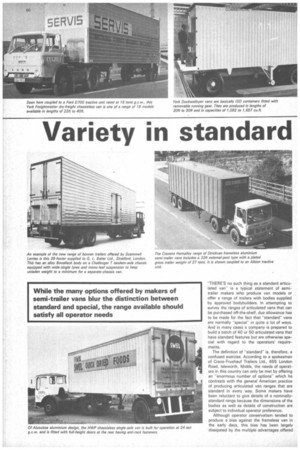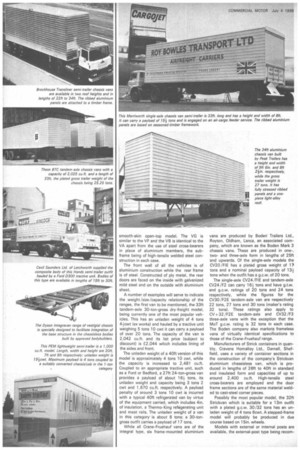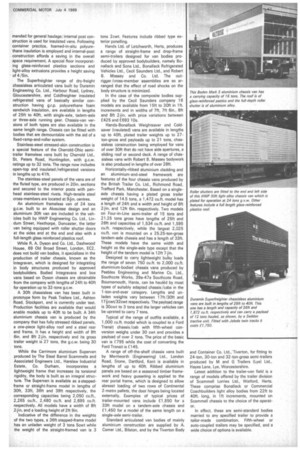Variety in standard
Page 62

Page 63

Page 64

Page 65

If you've noticed an error in this article please click here to report it so we can fix it.
:railer vans by P.A.C. Brockington, M I MechE
While the many options offered by makers of semi-trailer vans blur the distinction between standard and special, the range available should satisfy all operator needs
"THERE'S no such thing as a standard articulated van" is a typical statement of semitrailer makers who produce van models or offer a range of trailers with bodies supplied by approved bodybuilders. In attempting to survey the ranges of articulated vans that can be purchased off-the-shelf, due allowance has to be made for the fact that -standard" vans are normally "specialin quite a lot of ways. And in many cases a company is prepared to build a batch of 40 or 50 articulated vans that have standard features but are otherwise special with regard to the operators' requirements.
The definition of -standard" is, therefore, a confused exercise. According to a spokesman of Crane-Fruehauf Trailers Ltd., 655 London Road, Isleworth, Middx, the needs of operators in this country can only be met by offering an "enormous number of options" which he contrasts with the general American practice of producing articulated van ranges that are standard in every way. Some makers have been reluctant to give details of a nominallystandard range because the dimensions of the bodies as well as details of construction are subject to individual operator preference.
Although operator conservatism tended to produce a bias against the frameless van in the early days, this bias has been largely dissipated by the multiple advantages offered by frameless construction. While weight-saving is a proven merit of frameless construction that has been acknowledged by operators since integral vans were first introduced, it has been wrongly assumed by some operators that a conventional articulated van necessadly has advantages in terms of ease of body repair and adaptability.
A technician of the York Trailer Co. Ltd., Corby, Northants, emphasizes that repair of the company's Freightmaster frameless vans is less costly than that of typical chassis vans. And of particular significance in view of the general increase in the size of vehicles the frameless van can be more readily extended to augment its capacity.
York says that the weight of a frameless van is typically the same as the weight of an equivalent platform outfit and that a basic structure can be stiffened to carry additional decks or a hanging load by the use of stub posts and so on without modifications to the structure.
Of all-aluminium construction, York Freightmaster vans are produced in drop-deck form with a single axle, as semi-drop-deck models having a single or tandem axle and as flat-deck semi-trailers with single-axle, tandem-axle and tri-axle running gear, the drop-deck and flat-deck models being offered with a Tasker automatic coupling. Flat-deck vans are available as exterior-post as well as interior-post models.
The automatics are produced in lengths of 22ft to 30ft in 1ft increments, whereas the remaining models have lengths from 22 /26ft (depending on the axle type) up to 40ft in increments of 6in. or 1ft according to size category and axle configuration, The range covers 18 models with multiple length variations with payloads of 8 tons (with a typical tractive unit) up to 23 tons in the case of a 27-ton-gross outfit and 22.2 tons for an outfit with the higher g.c.w. of 32 tons. A 38-ton g.c.w. outfit could carry a payload of 28 tons.
• Optional Freightmaster features include an open top, double and triple decks, various types of door and shutter for the full-width rear opening, aluminium and steel racking, Joloda and roller tracks and tail lifts operated from the power take-off or (electrically) from the mains.
Freightmaster reefer vans are insulated with polyurethane sandwich, have bonded linings and are fitted with pressure-sealed doors and air-flow floors. Options include a meat-rail system with a weight capacity of 20 tons. As an indication of cost, the price may be cited of the popular 1824 single-axle van trailer built for operation at a g.c.w. of 24 tons. This has a length, width and height of 32ft, aft 2in. and 7ft Sin. respectively, can
carry a payload of 17 tons and costs £2,094, subject to discount.
York City Vans are based on I-beam cross-bearers at 24in. centres and the four models vary in length from 22ft 2in. up to 30ft 214-in. in 2in. increments. The gross trailer weight is 10 tons in each case while the approximate net payload is 8 tons.
Basically an ISO steel container with detachable running gear, the company's Dockwalloper is produced in lengths of 20ft to 30ft, the weights of the smallest and largest models being 3 tons 5cwt and 4 tons 2cwt respectively. The cubic capacities of these models are 1,092 cuff. and 1,657 cuff. respectively and prices are from £1,355.
Suitable for mounting on standard semitrailer chassis, York Truck Van aluminium bodies are produced in kit form in five lengths of 14ft to 24ft, widths of 7ft to Bit 2in. and heights of 6ft to 8ft. The weight of the 14ft body is 8281b. 95Ib being added for each increment of 2ft. Options include a 45in. side aperture with a hinged door and a 46in. aperture with an aluminium roller shutter
Built in lengths of 20ft to 40ft, the ranges of Crane-Fruehauf Vanguard frameless aluminium vans comprise the VF NG, the VANB and OA /0B, the VF /VG being an exposedpost dry-freight type while the VANB is an insulated /refrigerated van and the OA /08 a smooth-skin open-top model. The VG is similar to the VF and the VB is identical to the VA apart from the use of steel cross-bearers in place of aluminium members, the subframe being of high-tensile welded steel construction in each case.
The front wall of all the vehicles is of aluminium construction while the rear frame is of steel. Constructed of ply metal, the rear doors are faced on the inside with galvanized mild steel and on the outside with aluminium sheet.
A number of examples will serve to indicate the weight/size/capacity relationship of the ranges, the first van to be mentioned, the 33ft tandem-axle 30-ton-gross dry-freight model, being currently one of the most popular vehicles. This has an unladen weight of 4 tons 41cwt (ex works) and hauled by a tractive unit weighing 5 tons 10 cwt it can carry a payload of over 20 tons, The capacity of the van is 2,042 cu.ft. and its list price (subject to discount) is £2,044 which includes lining of the sides and front.
The unladen weight of a 40ft version of this model is approximately 4 tons 10 cwt, while the capacity is increased to 2,481 cult. Coupled to an appropriate tractive unit, such as a Ford or Bedford, a 27ft 24-ton-gross van provides a payload of about 16+ tons, its unladen weight and capacity being 3 tons 2 cwt and 1,670 cu.ft. respectively. A payload penalty of around 3 tons 10 cwt is incurred with a typical 40ft refrigerated van by virtue of the equipment carried, which includes 4in. of insulation, a Thermo-King refsigerating unit and meat rails. The unladen weight of a van in this category is about 8 tons; a 30-tongross outfit carries a payload of 17 tons.
While all Crane-Fruehauf vans are of the integral type, six frame-mounted aluminium
vans are produced by Boden' Trailers Ltd., Royton, Oldham, Lanes, an associated company, which are known as the Baden Mark 3 chassis vans. These are produced in one-, twoand three-axle form in lengths of 25ft -and upwards. Of the single-axle models the CV20 /FIE has a plated gross weight of 1 tons and a nominal payload capacity of 131 tons when the outfit has a g.c.w. of 20 tons.
The single-axle CV24 /FIE and tandem-axle CV24 /F2 can carry 16+-tons and have 0.w. and g.c.w. ratings of 20 tons and 24 tons respectively, while the figures for the CV30 /F2E tandem-axle van are respectively 22 tons, 27 tons and 30 tons (maker's rating 32 tons). These ratings also apply to CV-4-32 /F2E tandem-axle and CV32 /F3 three-axle vans with the exception that the MoT g.c.w. rating is 32 tons in each case. The Braden company also markets frameless vans of virtually identical specifications to those of the Crane-Fruehauf range.
Manufacturers of Strick containers in quantity, Cravens Homalloy Ltd., Darnall, Sheffield, uses a variety of container sections in the construction of the company's Strickvan aluminium chassisless van, which is produced in lengths of 26ft to 40ft in standard and insulated form and capacities of up to around 2,400 cult. High-tensile steel cross-bearers are employed and the door frame sections are of the same material welded to cast-steel corner pieces.
Possibly the most popular model, the 32ft Strickvan which is suitable for a 13m outfit with a plated g.c.w. 30/32 tons has an unladen weight of 4 tons 6cwt. A stepped-frame model will probably be produced in due course based on 15in. wheels.
Models with external or internal posts are available, the external-post type being recom mended for general haulage; internal post con struction is used for insulated vans. Following container practice, foamed-in-situ polyure thane insulation is employed and internal-post construction affords a saving in the overall space requirement. A special floor incorporat ing glass-reinforced plastics sections and light-alloy extrusions provides a height saving of 4 /5in.
The Superfreighter range of dry-freight chassisless articulated vans built by Duramin Engineering Co. Ltd., Harbour Road, Lydney, Gloucestershire, and Coldfreighter insulated refrigerated vans of basically similar construction having g.r.p. polyurethane foam sandwich insulation, are available in lengths of 25ft to 40ft, with single-axle, tadem-axle or three-axle running gear. Chassis-van versions of both types are also available in the same length range. Chassis can be fitted with bodies that are demountable with the aid of a fixed-ramp-and-roller system.
Stainless-steel stressed-skin construction is a special feature of the Charrold-Ohio semitrailer frameless vans built by Charrold Ltd., St. Peters Road, Huntingdon, with g.c.w. ratings up to 32 tons. The range now includes open-top and insulated /refrigerated versions in lengths up to 41 ft The stainless-steel panels of the vans are of the fluted type, are produced in 20m. sections and secured to the interior posts with panhead stainless-steel rivets. High-tensile steel cross-members are located at 9iin. centres.
An aluminium frameless van of 24 tons g.c.w. built to an Alusuisse design and an aluminium 30ft van are included in the vehicles built by HWP Engineering Co. Ltd., Lindum Street, Hexthorpe, Doncaster, the latter van being equipped with roller shutter doors at the sides and at the end and also with a full-length glass reinforced plastics roof.
While R. A. Dyson and Co. Ltd., Dashwood House, 69 Old Broad Street, London, EC2, does not build van bodies, it specializes in the production of trailer chassis, known as the Integravan, which is designed for integrating in body structures produced by approved bodybuilders. Bodied Integravans and box vans based on Dyson chassis are obtainable from the company with lengths of 24ft to 40ft for operation up to 32-tons g.c.w.
A 30ft chassisless van has been built in prototype form by Peak Trailers Ltd., Ashton Road, Stockport, and is currently under test. Production facilities are available that would enable models up to 40ft to be built. A 34ft aluminium chassis van is produced by the company that has fully stressed ribbed panels, a one-piece light-alloy roof and a steel rear end frame. It has a height and width of 9ft 6in. and 8ft 2iin. respectively and its gross trailer weight is 27 tons, the g.c.w. being 30 tons.
While the Carrimore aluminium Supervan produced by The Steel Barrel Scammells and Associated Engineers Ltd., Harelaw Industrial Estate, Co. Durham, incorporates a lightweight frame that increases its torsional rigidity, the body is built as an integral structure. The Supervan is available as a steppedframe or straight-frame model in lengths of 30ft, 33ft, 36ft and 39ft respectively, the corresponding capacities being 2,050 cu.ft., 2,265 cu.ft., 2,480 cult and 2,695 cult respectively. All models have a width of 8ft 2+in. and a loading height of 2ft 9in.
Indicative of the difference in the weights of the two types, a 36ft stepped-frame model has an unladen weight of 3 tons 5cwt while the weight of the straight-framed van is 3 tons 2cwt. Features include ribbed type exterior panelling.
Hands Ltd. of Letchworth, Herts, produces a range of straight-frame and drop-frame semi-trailers designed for van bodies produced by approved bodybuilders, namely Bonallack and Sons Ltd., Bonallack Refrigerated
Vehicles Ltd., Cecil Saunders Ltd., and Robert B. Massey and Co. Ltd. The out
rigger /cross-member assemblies are so arranged that the effect of road shocks on the body structure is minimized.
In the case of the composite bodies supplied by the Cecil Saunders company 16 models are available from 15ft to 30ft in 1ft. increments and in widths of 7ft, 7ft Sin.. 8ft and 8ft 2in. with price variations between £425 and £693 10s.
Hands-Bonallack Weightsaver and Coldsaver (insulated) vans are available in lengths up to 40ft, plated trailer weights up to 27 ton-gross and payloads up to 21 tons, chassisless construction being employed for vans of over 30ft that do not have side apertures, a sliding roof or second deck. A range of chassisless vans with Robert B. Massey bodywork is also produced in lengths of over 28ft.
Horizontally-ribbed aluminium cladding and an aluminium-and-steel framework are features of the four chassis vans produced by the British Trailer Co. Ltd., Richmond Road, Trafford Park, Manchester. Based on a single axle chassis having a plated gross trailer weight of 14.5 tons, a 1,472 cu.ft, model has a length of 24ft and a width and height of 8ft 21in. and 12ft Sin. respectively. Two models on Four-in-Line semi-trailer of 15 tons and 21.25 tons gross have lengths of 25ft and 26ft and capacities of 1,534 cu.ft. and 1,595 cult respectively, while the largest 2,025 cu.ft. van is mounted on a 25.25-ton-gross tandem-axle chassis and has a length of 331t. These models have the same width and height as the single-axle type except that the height of the tandem model is 12ft 7-i-in.
Designed to carry lightweight bulky loads the range of seven 750 cu.ft. to 2,000 cu.ft.
aluminium-bodied chassis vans produced by Peebles Engineering and Marine Co, Ltd., Southcote Works, 39a-47a Southcote Road, Bournemouth, Hants, can be hauled by most types of suitably adapted chassis /cabs in the 1-ton-and-over category. Lengths and un laden weights vary between 17ft/30ft and 17-1cwt/32cwt respectively. The payload.range is 30cwt to 3 tons and the larger vehicles can be uprated to carry 7 tons, Typical of the range of outfits available, a 1,000 cu.ft. model which is coupled to a Ford Transit chassis/cab with fifth-wheel conversion weighs under 30 cwt and provides a payload of over 2 tons. The price of the basic van is £795 while the cost of converting the Ford Transit is £145.
A range of off-the-shelf chassis vans built by Merriworth (Engineering) Ltd., London Road, Stone, Dartford, Kent is available in lengths of up to 40ft. Ribbed aluminium panels are based on a seasoned timber frame work and heavy gusseting is applied to the rear portal frame, which is designed to allow abreast loading of two rows of Continental 2-metre pallets, the door hinges being located externally. Examples of typical prices of trailer-mounted vans include £1,850 for a 33ft model on a tandem-axle chassis and £1,450 for a model of the same length on a single-axle semi-trailer.
Standard articulated van bodies of mainly aluminium construction are supplied by A. Corner Ltd., Bilston, and by the Tiverton Body and Container Co. Ltd., Tiverton, for fitting to 24-ton, 30-ton and 32-ton-gross semi-trailers produced by M and 0 Trailers (Lye) Ltd., Hayes Lane, Lye, Worcestershire, Latest addition to the trailer-van field is a range of models offered by the trailer division of Scammell Lorries Ltd., Watford, Herts. These comprise Bonallack or Commercial Coachbuilders light alloy bodies from 22fit to 40ft. long, in 1ft increments, mounted on Scarnmell chassis to the choice of the operator.
In effect, these are semi-standard bodies married to any specified trailer to provide a tailor-made combination. Fifth-wheel or auto-coupled trailers may be specified, and a wide choice of options is available.




























































































































































